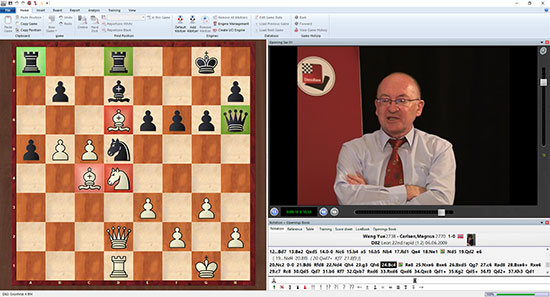


GM Adrian Mikhalchishin is quick to acknowledge just how much theory has evolved, sharing anecdotes of players whose preparation went as far as 40, 50, and even 60 moves ahead. As a grandmaster who has been a part of generations of competition, he has not only observed but participated firsthand in the evolution of the openings, not just in moves and lines, but general principles.
He explains that in the 80s, a theme that became particularly popular was the pawn sacrifice in the opening to gain an attack, initiative, or simply some interesting compensation while giving the position an imbalanced characteristic. Some of the most active exponents were players such as Oleg Romanishin and the world champion Garry Kasparov, who used this to great effect.

The lecture is highly enjoyable and one that will be watched more than once for the fun-factor
In the present day, he has noticed an evolution to that theme: the exchange sacrifice. It is not that exchange sacrifices in the opening came into existence now, naturally not, but that their popularity has grown and more and more varied examples are appearing in master and grandmaster play.
In a series of lectures spanning 12 commented games, GM Mikhalchishin illustrates a few common themes on when and how they are most often seen nowadays, and of course how they are exploited or defeated. Don’t think this is a series of games trying to sell the idea “Sac the exchange and win”. Sometimes they succeed, sometimes not, but in all cases they yield interesting and dynamic play for the players bold enough to try (and those bold enough to accept!).

The author explains clearly what is going on and what the important factors are
The first game, exposing the course’s driving theme, is a game between Wang Yue, and none other than Magnus Carlsen. It is a wonderful game to watch, fun and full of action, and some of the main ideas already come across. Sometimes these games are the fruit of world championship caliber preparation, such as the battle between Vishy Anand and Veselin Topalov in their World Championship match in 2010, while others can even be the result of fine intuition in a spur-of-the-moment decision, with the guts to follow it through, as seen in the game Grischuk-Riazantsev.
Exchange sacrifices can even be planned from the very beginning as in this no-holds barred example
In all cases, not only are we privy to a variety of examples of interesting exchange sacrifices, but also attacking concepts, defensive ideas, and more. The games are all well-chosen and the presentation is to the point and instructive. Overall, the concept fits the 60-minute course model perfectly, and for the modest asking price, one gets a top-notch lesson from one of the world’s best coaches.
You can purchase "The strategical opening exchange sacrifice in 60 minutes" in the ChessBase Shop